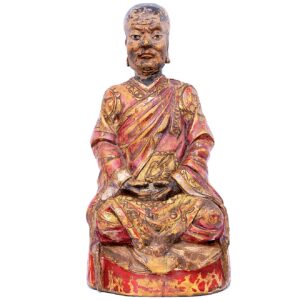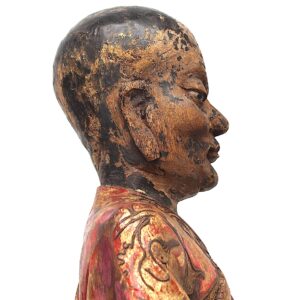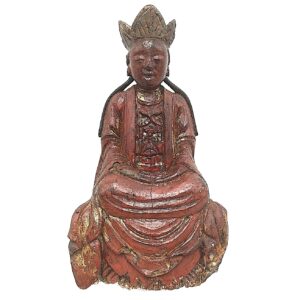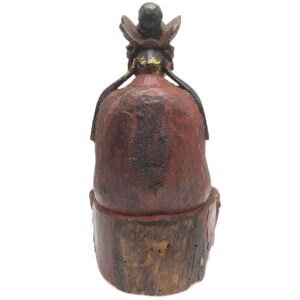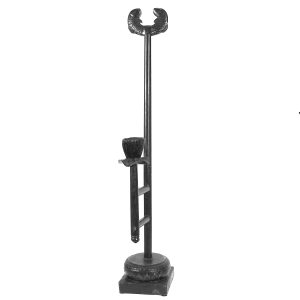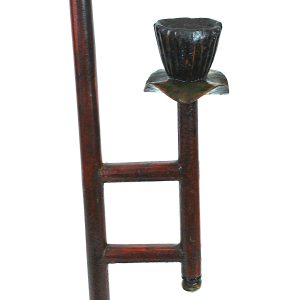Showing 73–84 of 102 results
-


$295.00
Ancestor worship has been practiced throughout China using carved wood figures of deities, monks, priests and ancestor figures on home altars. In recent years there has been a resurgence of ancestor worship, especially in local Chinese communities practices by Buddhists, Taoists, and Popular Religion followers. Carvings of Taoist priests called daoshi often hold Taoist symbols…
-


$525.00
The Queen Mother of the West (Xiwangmu) is the most significant of the female Taoist deities and is viewed as having magical powers to controls life, death, creation and destruction and determines the lifespan of every living being. She lives with her husband the Jade Emperor in Kunlun Mountain where she attends her famous garden…
-
Sale!


$425.00 Original price was: $425.00.$310.00Current price is: $310.00.
Ht: 1.25″ W: 15″ D:14.87″ | CALL 213-568-3030 OR EMAIL [email protected] FOR SHIPPING COST
This intricately hand carved gold and silver platter with indentations on both sides was used to make confections called sweetmeats eaten at festivals, holidays, and other key celebrations. The round molds symbolize the moon and cohesion of the family. The 5-petal plum blossoms attached to vines symbolize purity and endurance, as well as the coming of spring, renewal, and longevity. The multiple seeds are a wish for fertility and sons, and thus this mold may have been a holiday and/or marriage gift to a young couple.
-
Sale!


$1,185.00 Original price was: $1,185.00.$975.00Current price is: $975.00.
H: 13.5″ W: 7.25″ D: 6″ | CALL 213-568-3030 OR EMAIL [email protected] FOR SHIPPING.
Seated in lalitsana, the position of royal ease, this delicate White Robed Guanyin is traditionally portrayed as a humble and modest deity, although she has a gilt lacquer surface. Her white hood is draped over a stylized image of Amitabha Buddha to whom she is a companion in Pure Land Buddhism, the most widespread Buddhist sect.
-


$785.00
18 original Lohans were the major disciples of Shakyamuni Buddha whom he, at his death bed, entrusted to protect and promulgate Buddhist teachings. Over centuries, their numbers increased to over 500 enlightened beings recognized for their courage and supernatural powers. In Mahayana Buddhism, Lohans represent the ideal toward which Buddhist devotees should strive as they…
-


$195.00
H: 5.25″ W: 4.5″ D: 2.875″ | FREE SHIPPING WITHIN CONTINENTAL U.S.!
This 19th-century miniature wood figure is a finely and whimsically carved portly seated merchant. He is depicted as a Laowai or “old foreigner” with a westernized face and hat and oversized hands placed on his knees. Seated on a platform base, he wears garments reflective of the Chinese culture at this time but wears a hat that is clearly not of Chinese origin. Other indications this charming figure is a foreigner include the roundness of his face, western facial features and oversized hands.
-
Sale!


$425.00 Original price was: $425.00.$300.00Current price is: $300.00.
H:9.75″ W: 5.6″ D: 3.75″ | FREE SHIPPING WITHIN CONTINENTAL U.S.!
This red lacquer and gilt covered image made for a home altar is a Pure Land Buddhist statue. Although it is a provincial image it has an elaborate headdress and decorative necklace of imperially sanctioned Guanyin images. Her 5-lobed crown is centered with radiating bars symbolizing Amitabha Buddha and his aureole that represents the flames of Buddhism.
-


$995.00
The Kitchen God (Zao Shen) was and still is among the most important Chinese house gods. Traditionally every family had its own Kitchen God with or without his wife above the stove to reflect his and its central position in the family’s life. The Kitchen God is both a syncretic and a tutelary deity embraced…
-
Sale!


$595.00 Original price was: $595.00.$395.00Current price is: $395.00.
H: 9.75″ W: 5″ D: 4.5″ | FREE SHIPPING within continental u.s.!
Nanhai Guanyin in her Cave in lalitsana, below draped moss arch holding a scrolls with vial of tears of her humanity and parrot, her constant companion. Small Nanhai images with all these symbols in this condition are very rare.
-


$325.00
H: 35″ W: 5.75″ D: 8″ CALL 213-568-3030 OR EMAIL [email protected] FOR SHIPPing
This charming oil lamp is decorated with auspicious symbols: Fish symbolize harmony, marital happiness and double fish mean “may there be abundance.” The oil cup is a lotus seed with a lotus leaf, symbols of a harmonious and fruitful marriage and also mean “the continuous birth of sons.”
-


$325.00
H: 35″ W: 5.75″ D: 8″ | | CALL 213-568-3030 OR EMAIL [email protected] FOR SHIPPING
This charming oil lamp is decorated with auspicious symbols: Fish symbolize harmony, marital happiness and double fish mean “may there be abundance.” The oil cup is a lotus seed with a lotus leaf, symbols of a harmonious and fruitful marriage and also mean “the continuous birth of sons,”
-


$575.00
Zhenwu (aka Xuanwu, Wuandi and Zhenwudadi) is one of the most revered Chinese Taoist figures, venerated for his ability to heal as well as to protect his country and the emperor. There are various depictions of his attire, but here he wears a plain black robe with an official’s belt which he holds in his…
End of content
End of content









